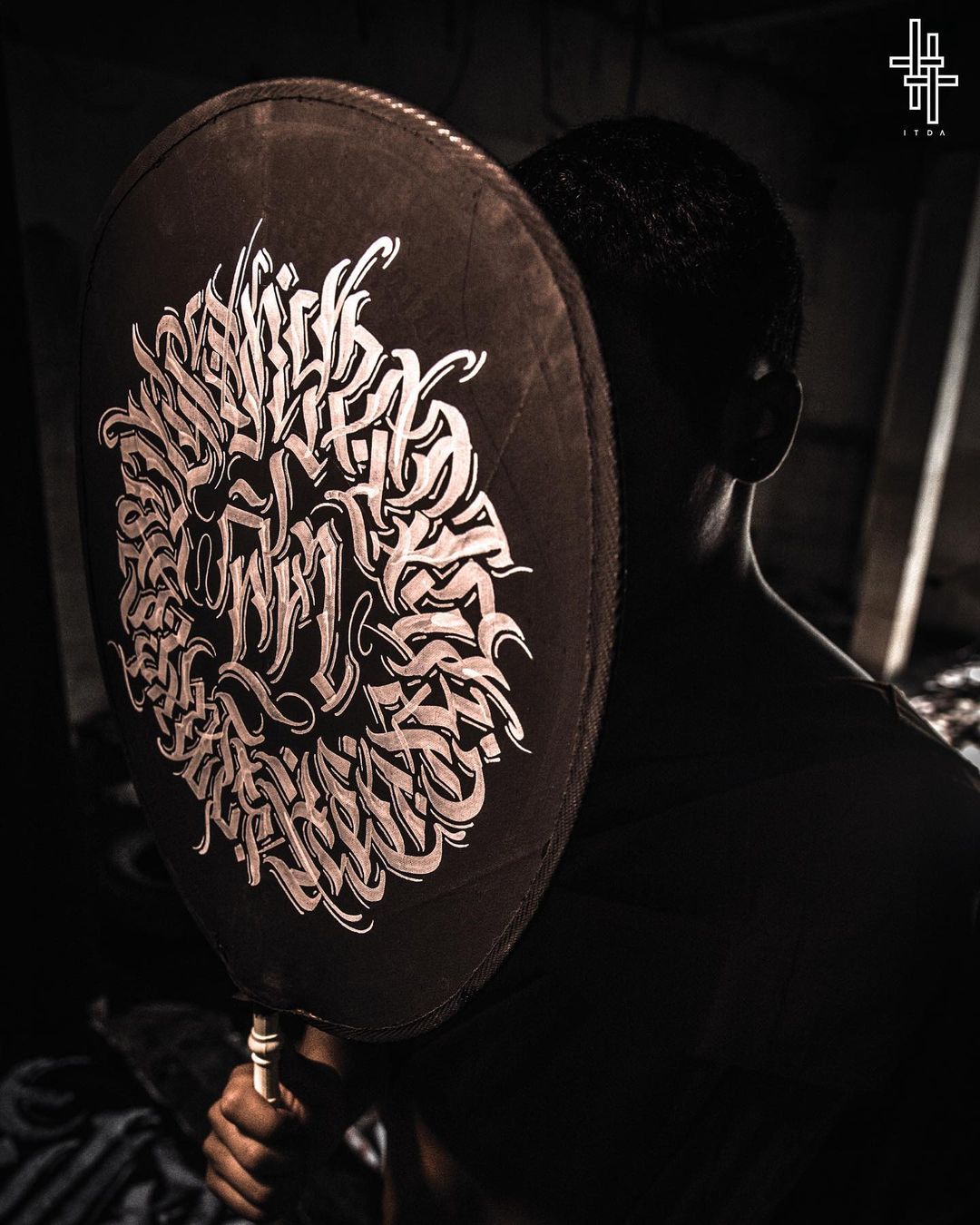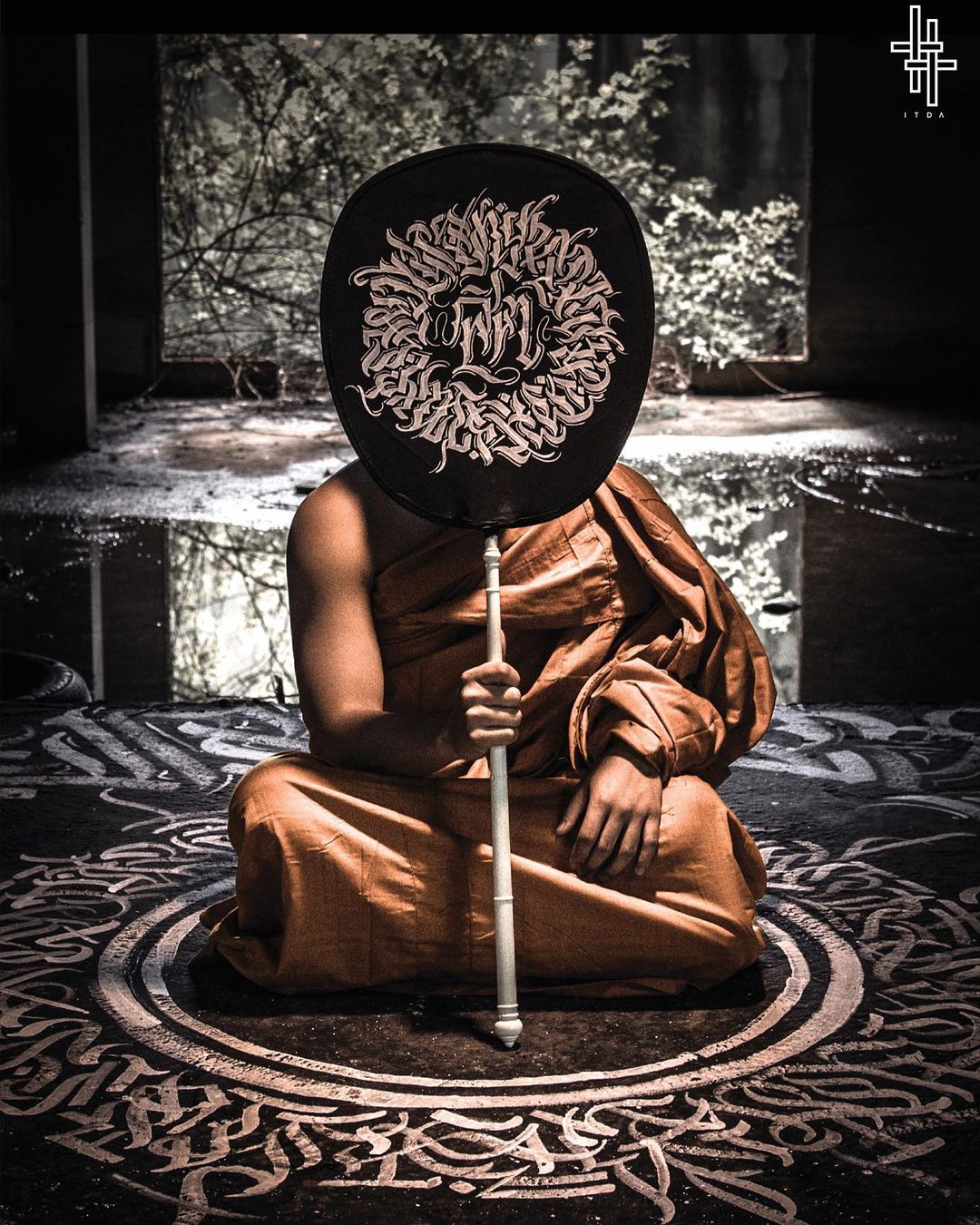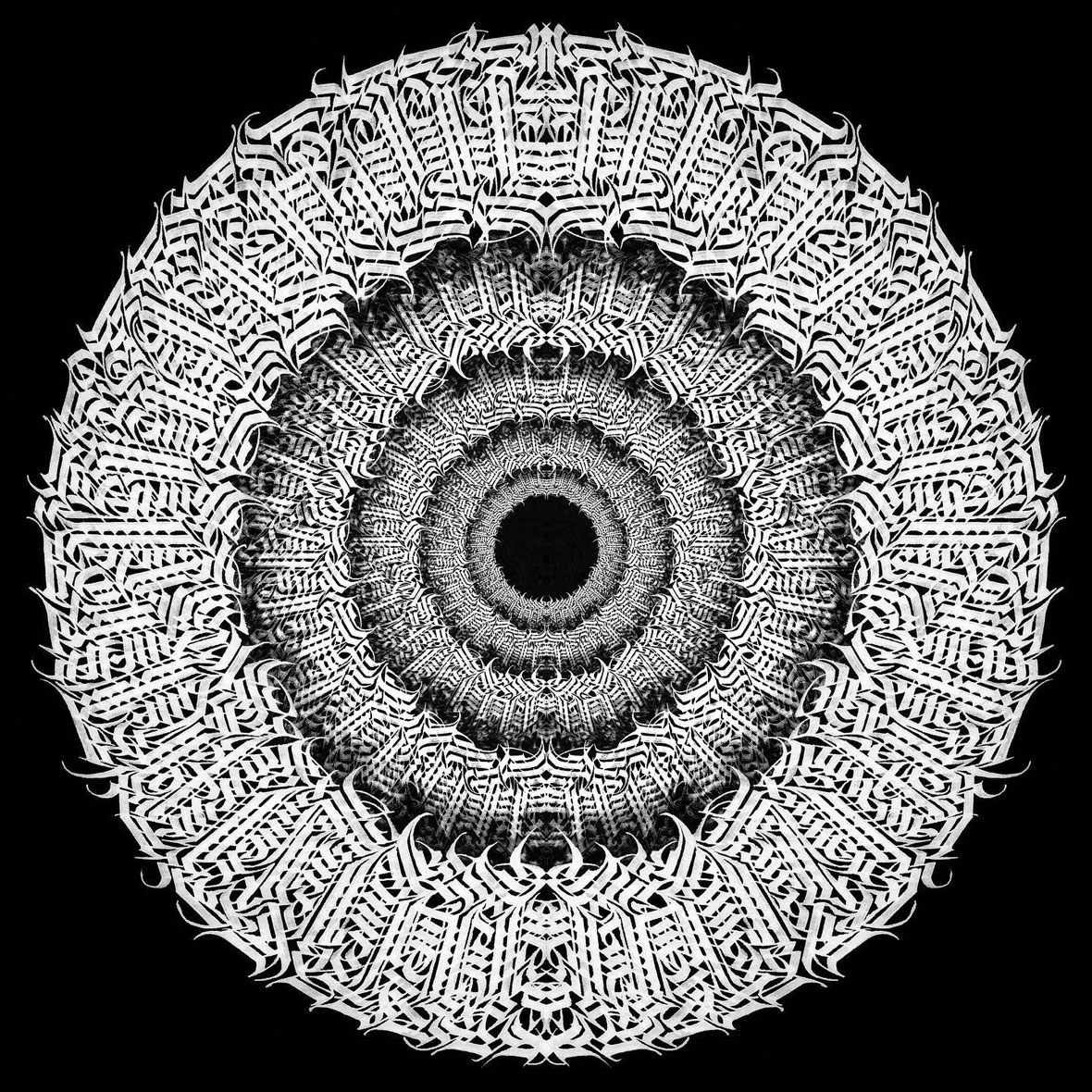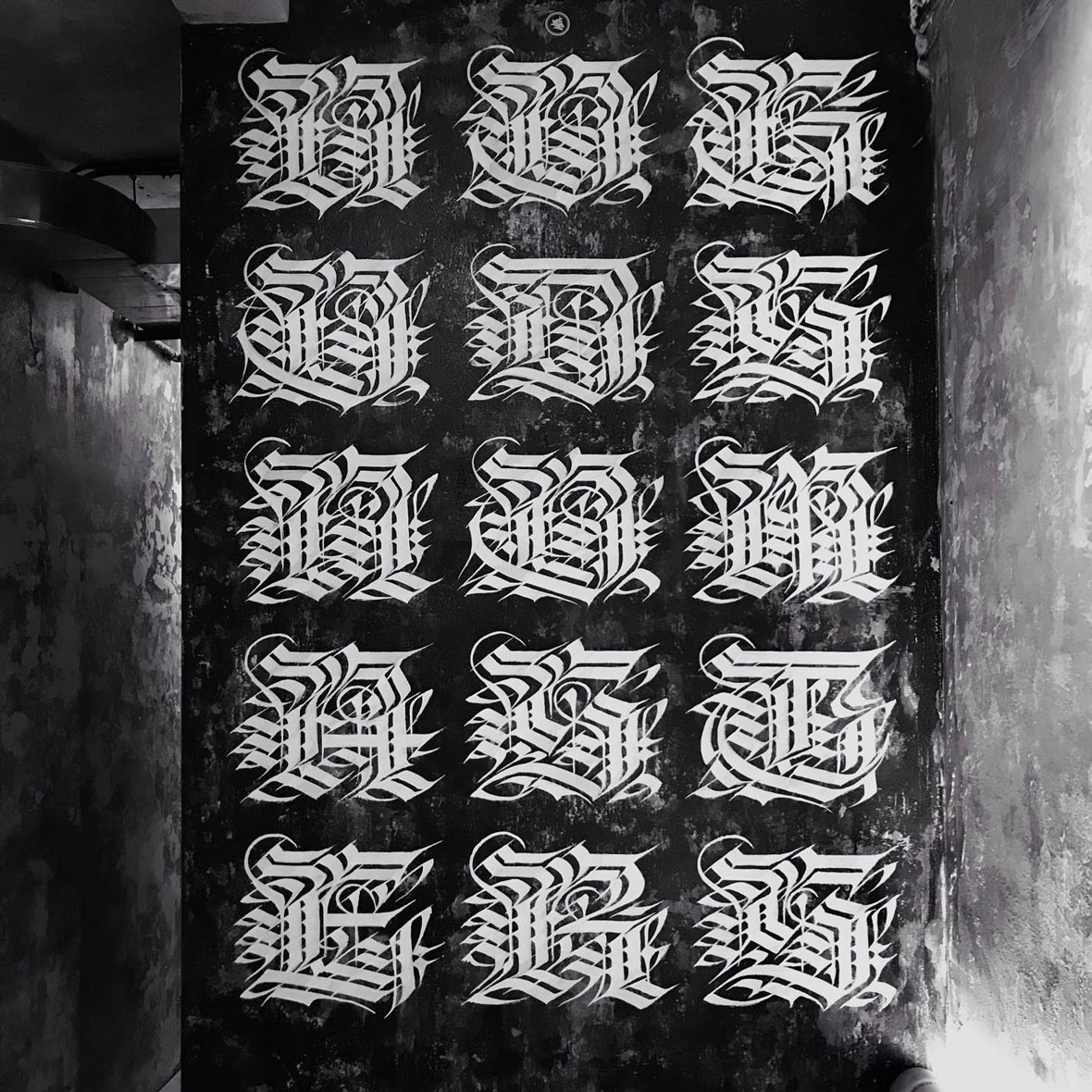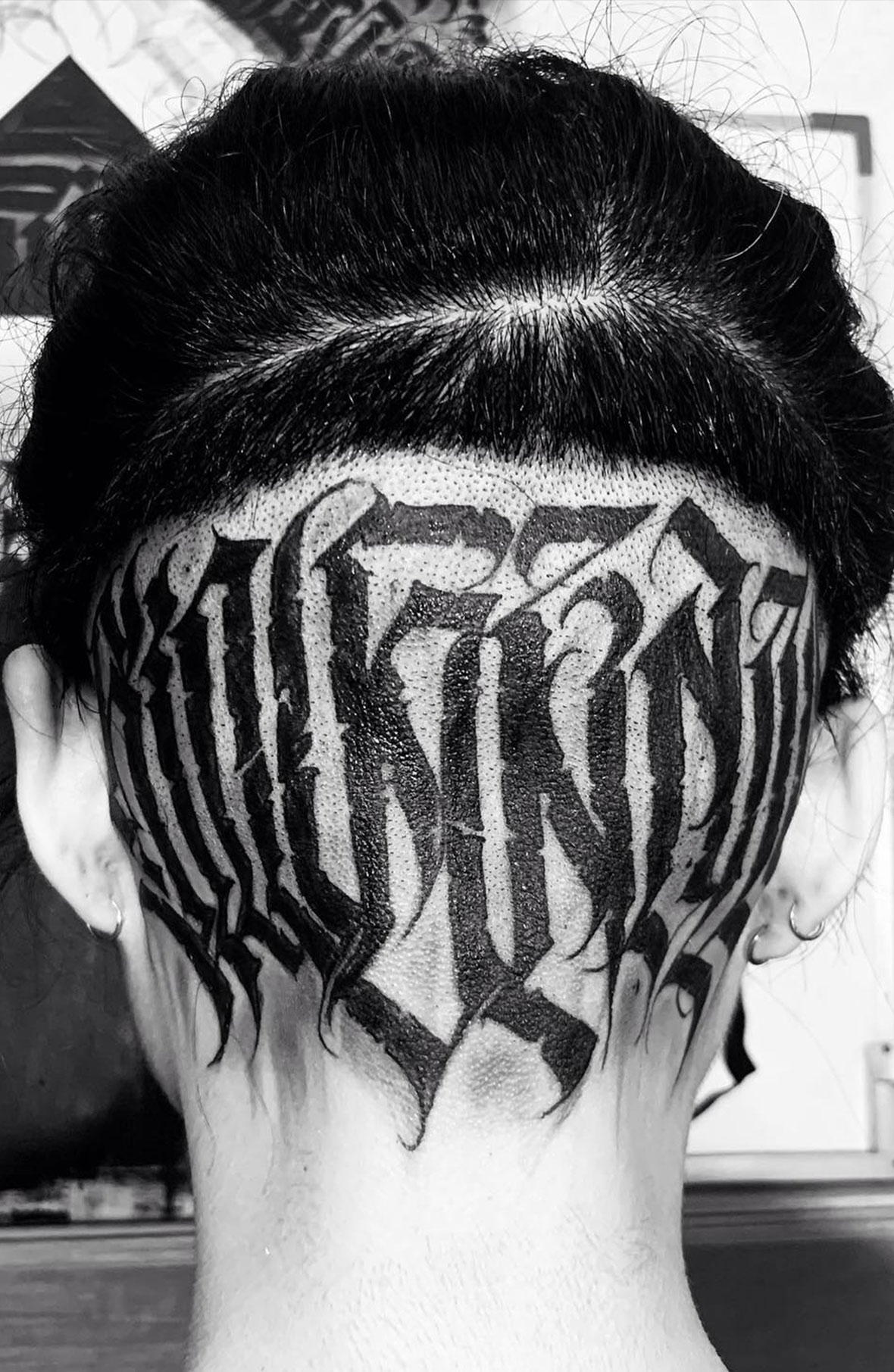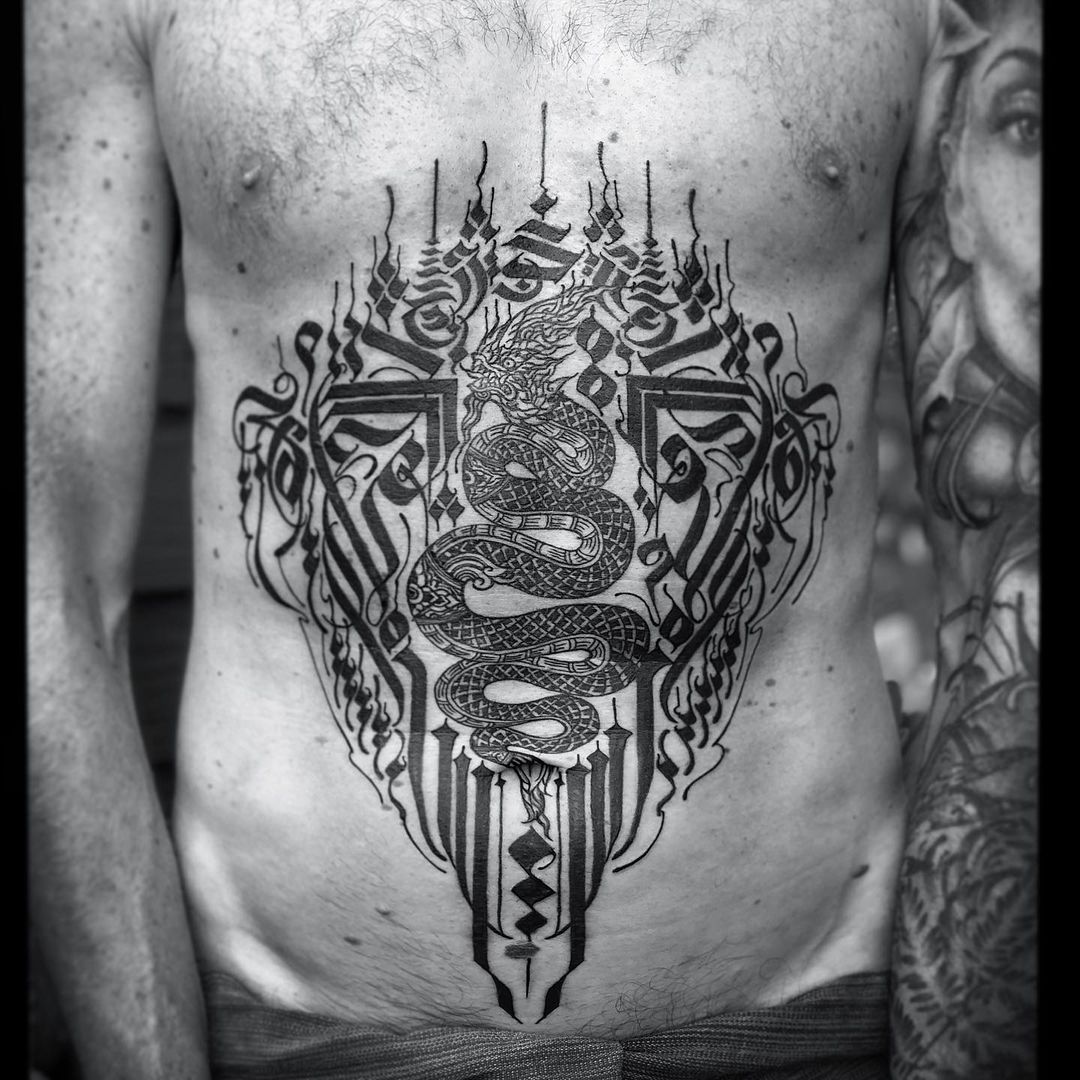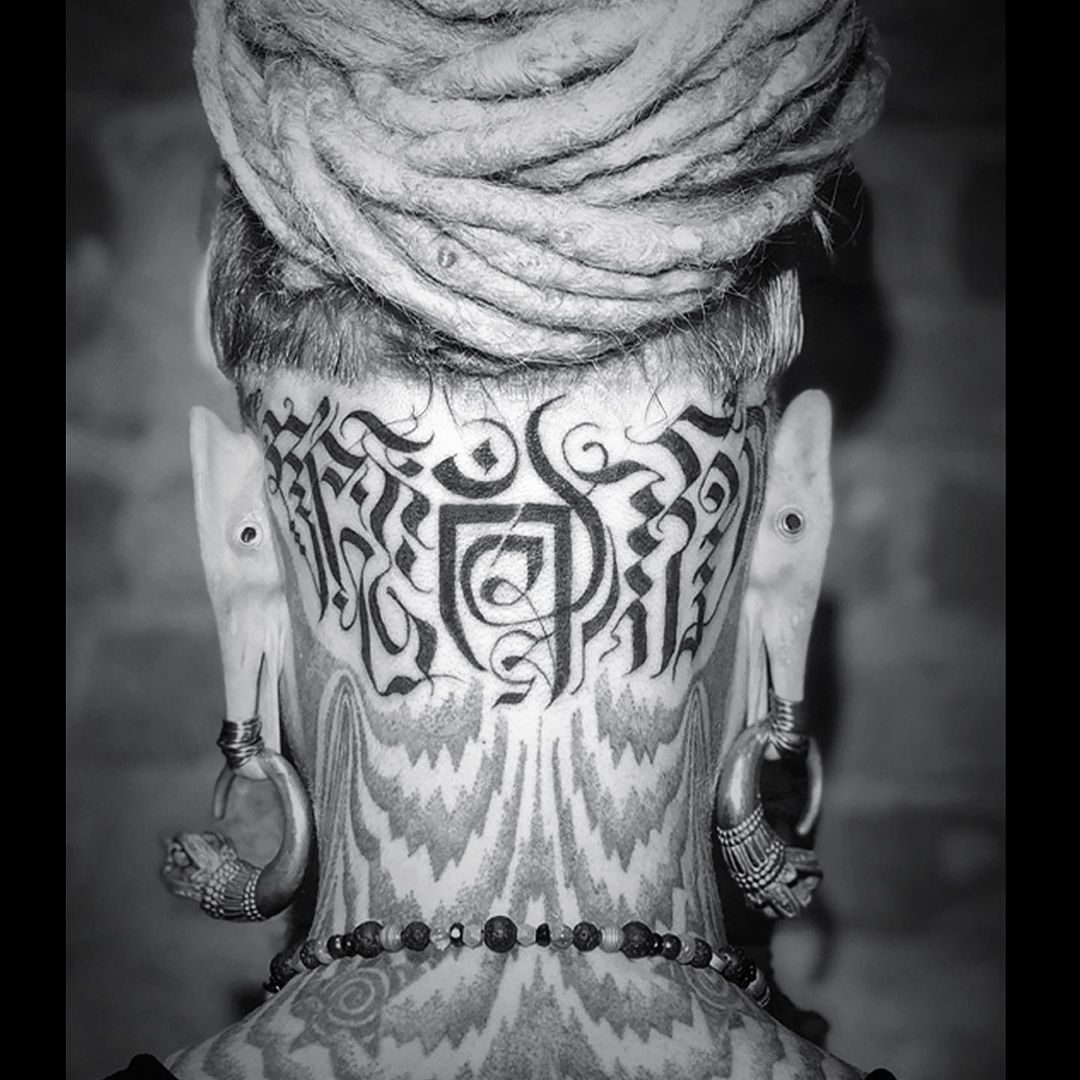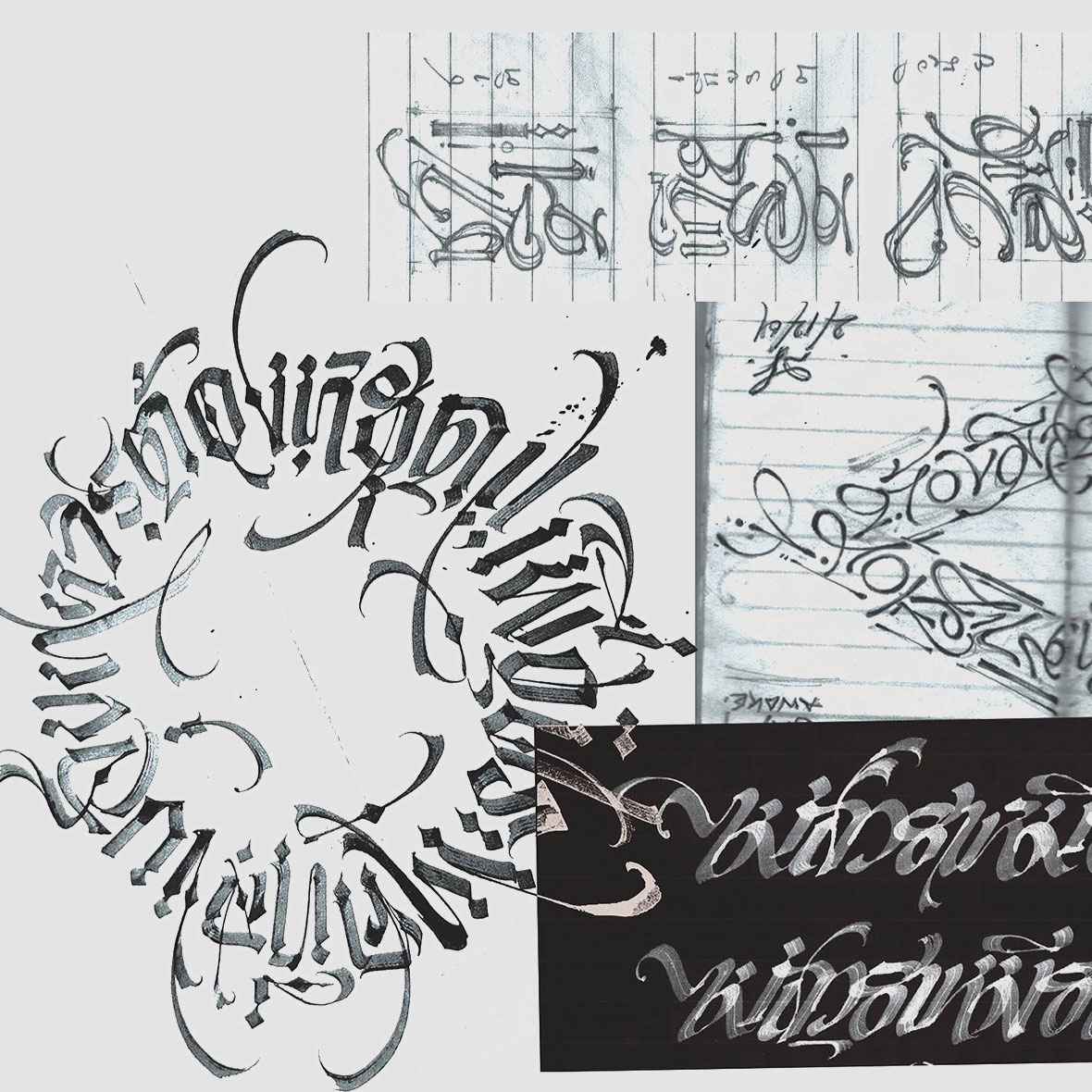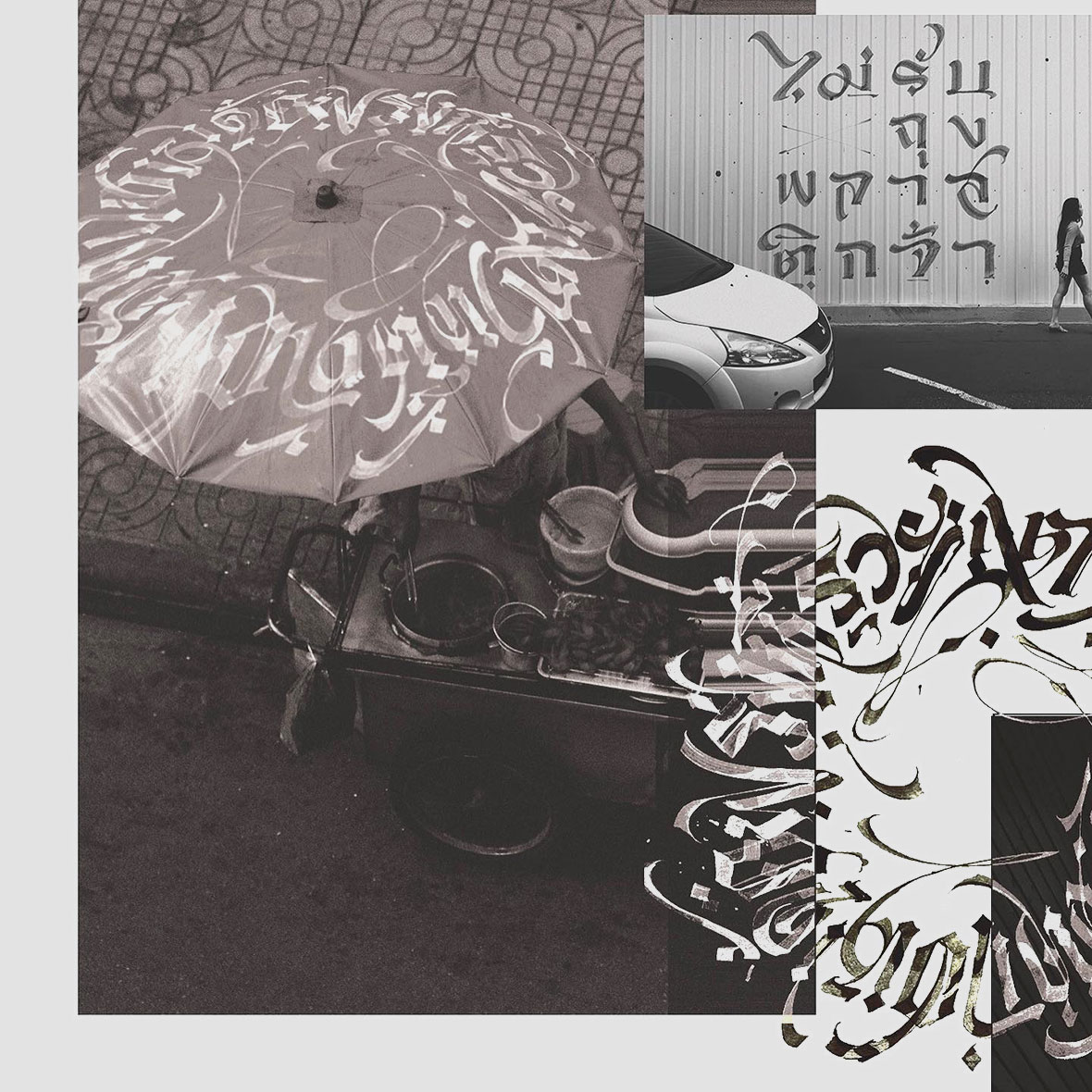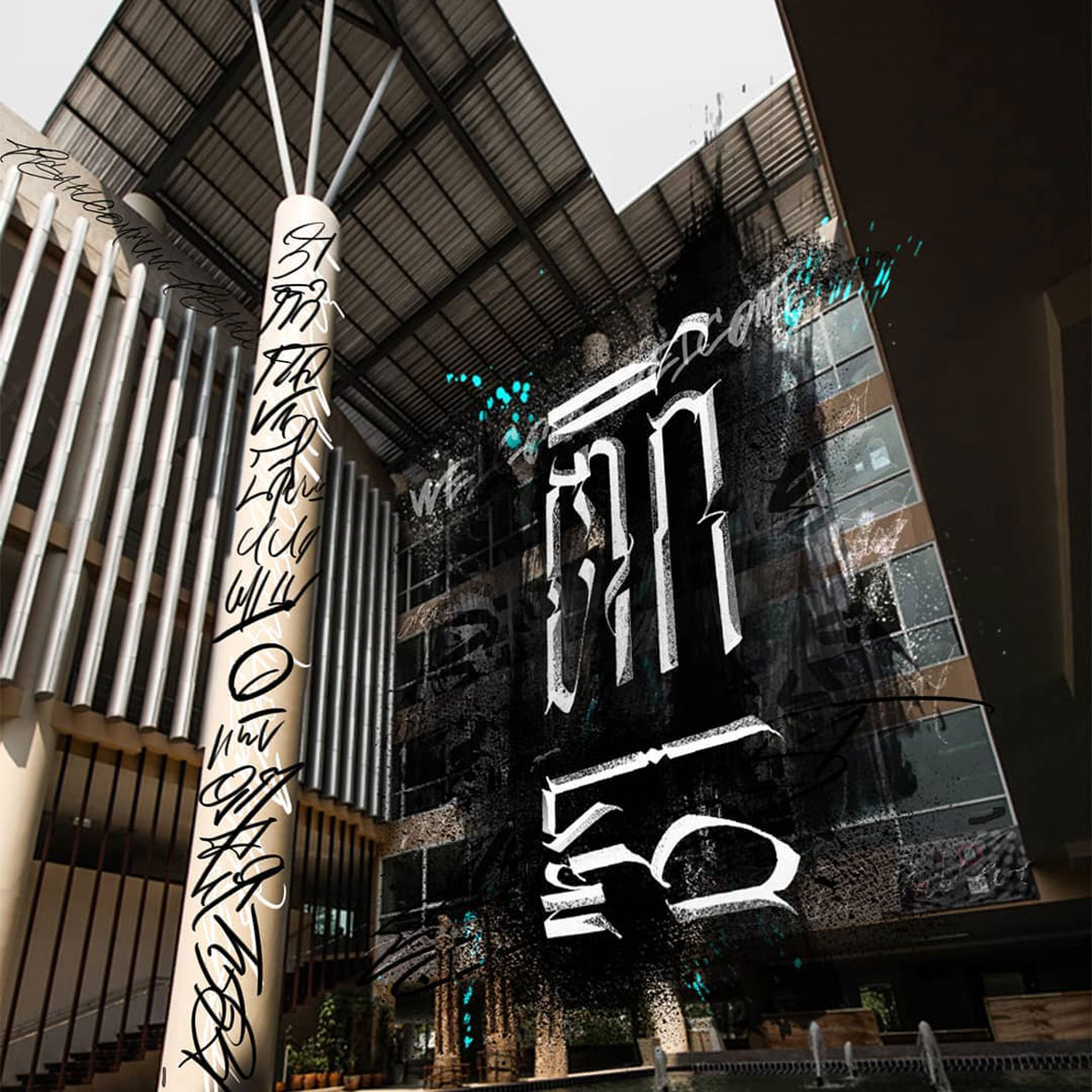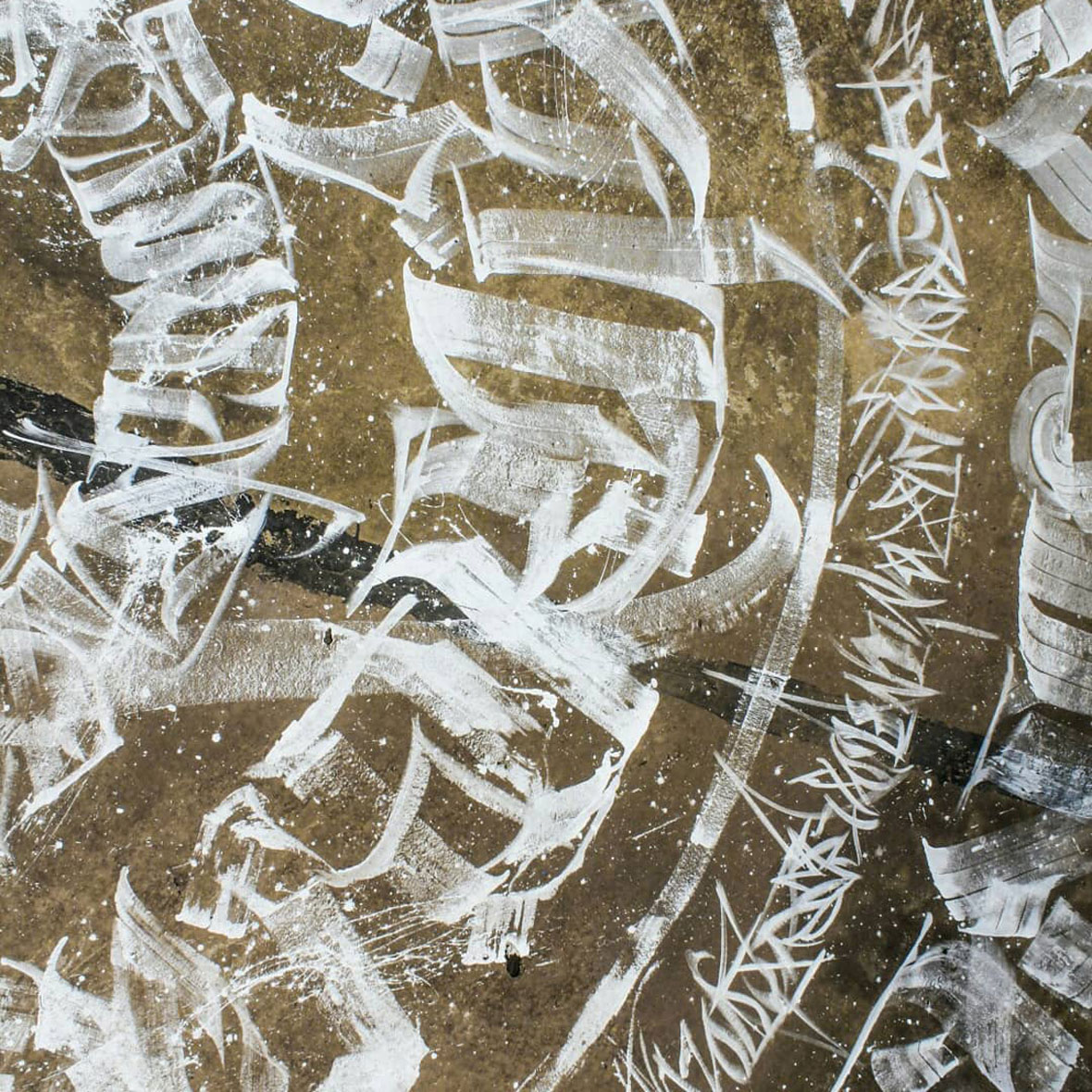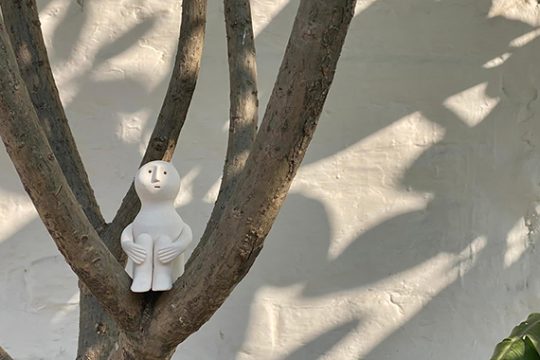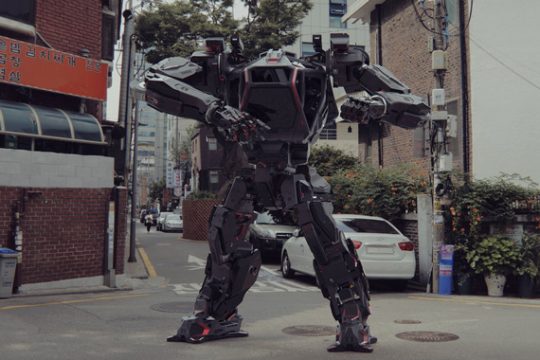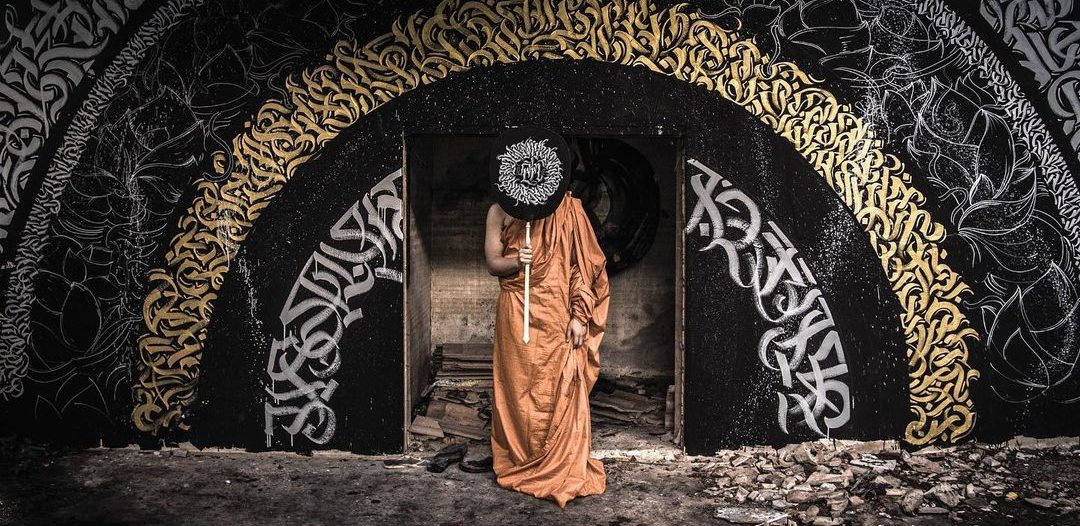
When it comes to calligraphy in Asia, China and Japan are usually front and center thanks to traditions stretching back to the early days of the written word. But Thailand shouldn’t be overlooked. The country now boasts a large and innovative scene that embraces everything from contemporary calligraphy and calligraffiti to script-based tattoo art. Although the scene is barely a decade old, there are already hundreds of calligraphists putting the country on the map.
These calligraphy-driven works appear as bold, hard-edged blackwork tattoos; figurative art built with lettering that creates the shapes of skulls and animals; installation work covering walls, floors, and ceilings; and mural art stretching down entire streets. Styles include European gothic calligraphy, Chicano styles from the US, experimental and Thai fonts blended with all the above.
English text is the most common, but Thai scripts appear alongside it too. Although it’s impossible to say exactly how many artists there are, since they come from all over the country, there are now 4,000 members in the Lettering Outlaws Thailand Facebook group. Some notable names today are Shi Lin, Sivakorn Soichampar, Watchara Tick, and Aumpol Mest, and WS Whitebear.
提及亚洲书法,中国和日本可能是你最先想到的国家,其毕竟拥有着悠久的书面文字传统。在如今蓬勃发展的泰国艺术场景中,当代书法、书法涂鸦和书法纹身艺术家们纷纷现身。仅短短十年时间里,当地便涌现出数百名书法艺术家,让这个东南亚国家在书法艺术领域占据一席之地。
与传统意义上的书法略显不同,泰国的书法艺术更具当代的多元气质,既有醒目硬朗的暗黑色系纹身(Black Work);利用字体勾勒骷髅和动物图案的具象艺术(Figurative Art);也有覆盖墙壁、地板和天花板的装置艺术作品;甚至与壁画艺术也有联系。作品中的字体包括欧洲哥特体、加州奇卡诺(Chicano)花体字、实验性作品以及泰文与上述字体风格的形式融合。这些作品通常以泰文和英语并重,字里行间表达了哲学或政治话题,也不乏一些牢骚和愤怒的观点。
创作泰国书法的艺术家分布于泰国各地,来自不同背景。现阶段,虽不能确切地统计具体从行人数,但在 Facebook 上一个名为“涉法字体“(Lettering Outlaws Thailand)的小组上,已有四千名成员在内,其中包括 Shi Lin、Sivakorn Soichampar、 Watchara Tick、Aumpol Mest 以及 WS Whitebear 等等当地稍有名气的艺术家。
Thai calligraphy was used in historic manuscripts called samut khoi, which originated in the 14th century, but there aren’t many other local examples until the past century, according to Dr. Santi Khunprasert, an associate professor at Chulalongkorn University. He says Thai calligraphy first flourished during the reign of HM King Vajiravudh (King Rama VI) in the early 1900s, and it was then popularized by movie poster artist Piak Poster in the 70s.
The contemporary calligraphy scene started about ten years ago, says Nareadom Phasukdee, an artist also known as BlackThoracic. In the beginning, artists didn’t have access to much equipment or support, so they had to make their tools by hand and learn with whatever information they could find. “It was quite hard to learn about languages and characters, since the only reference sources were foreign books and the internet, most of it from the West,” says Phasukdee, who’s been involved in calligraphy for about six years now. “Thai calligraphy is mainly influenced by European cultures, which became popular around 2007.”
据朱拉隆功大学副教授 Santi Khunprasert 博士所言,泰文书法从 14 世纪起便出现于一部名为《samut khoi》的历史手稿中,但直到上个世纪才逐渐被本地艺术家用于创作。教授表示,泰文书法最早兴起于泰王拉玛六世瓦栖拉兀统治时期,后由电影海报艺术家 Piak Poster 于上世纪七十年代推广开来。
艺术家 Nareadom Phasukdee(化名 BlackThoracic)介绍说,当代泰文书法场景的萌芽大约出现在十年前。起初,由于创作工具和资源扶持的匮乏,艺术家们不得不亲自制作工具,想尽一切办法学习。他接着说:“学习字体比想象中难,当时唯一的参考来源是外国书籍和网站,其中大部分内容都来自西方国家。”他毕业于曼谷兰实大学设计学院,从事书法创作已有大约六年时间。“泰国书法艺术主要受欧洲文化影响,大概在 2007 年才开始受到关注。”
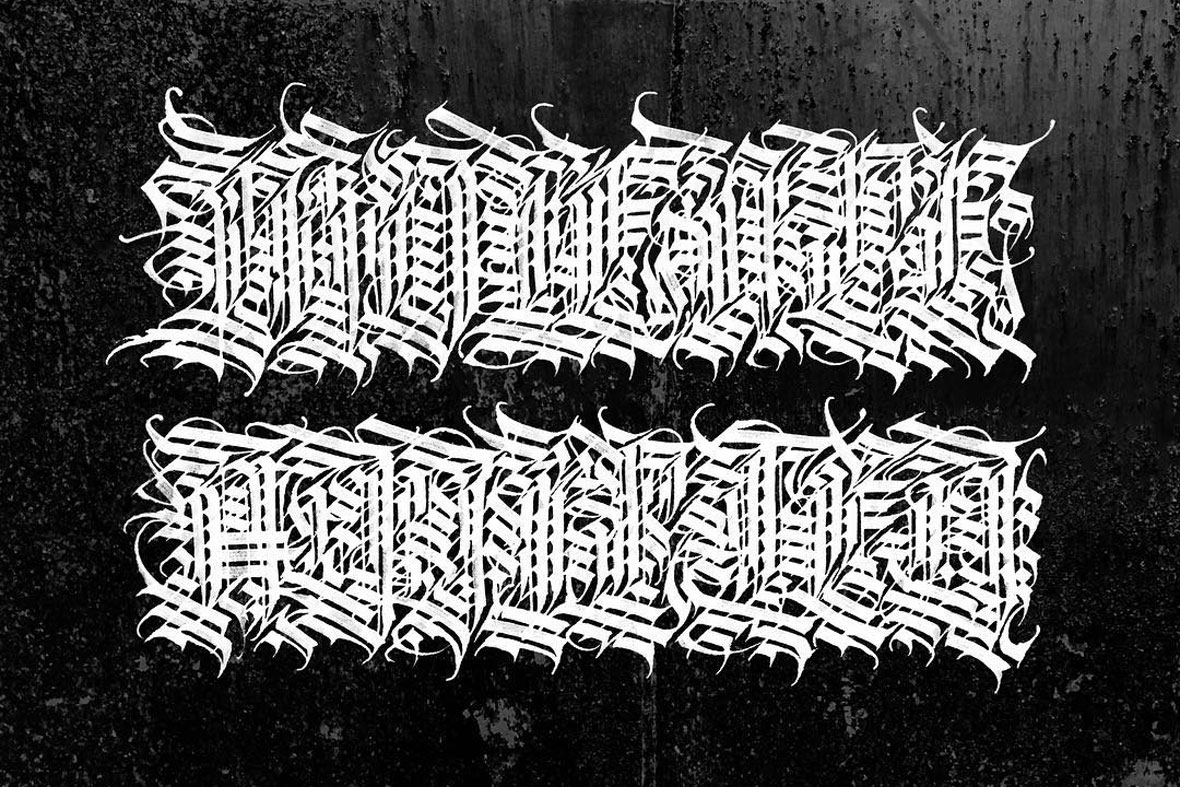
Arguably the biggest influence has been Chicano culture, a Mexican-American movement that celebrates and acknowledges their history and struggle, and is found primarily in Southern California and the American Southwest. There are a few types of lettering associated with Chicano culture. The style with the deepest roots is Cholo lettering, which comes from Latino gang graffiti going back as far at the 1940s. Chaz Bojorquez—often called the godfather of West Coast graffiti—is the most famous artist using this style. He was captivated by the gang graffiti around his Los Angeles neighborhood in the 60s and embraced it as a legitimate art form, introducing it to the rest of the world. Old English is another lettering staple and is a foundation of Chicano black and grey tattoo culture that has also resulted worldwide impact. Scripts, the loopy and elegant font used for more sensitive topics like family and religion, are another foundational letterform popularized through tattoos. And there are lowrider plaques, but those letters don’t have any particular style and vary widely.
泰国当代书法受到了来自奇卡诺文化的显著影响。奇卡诺(墨西哥裔美国人运动)文化本身深受欧洲书法的影响,其也对泰国书法产生微妙联系。这一文化自九十年代以来在泰国本土普及,时至今日仍然备受青睐。
Cholo 字体是奇卡诺文化的典型代表,这种字体来自上世纪四十年代拉丁匪帮涂鸦。Chaz Bojorquez 是当时美国西海岸拉丁帮派涂鸦的教父级人物。六十年代,他的涂鸦被官方承认,并流传至世界各地。
古英文书写体,是奇卡诺文化的又一代表,为之后黑灰纹身(Black-and-Grey-Tattoo)风格在世界范围内的传播打下了基础。该字体圆润优雅,往往关于家庭和宗教等更敏感类话题,被广泛运用于纹身创作。还有一些是放置于轿车尾部的 Lowrider 字体,但这些字体往往没有特定的风格,且形态各异,但同样是奇卡诺文化的标志性元素。
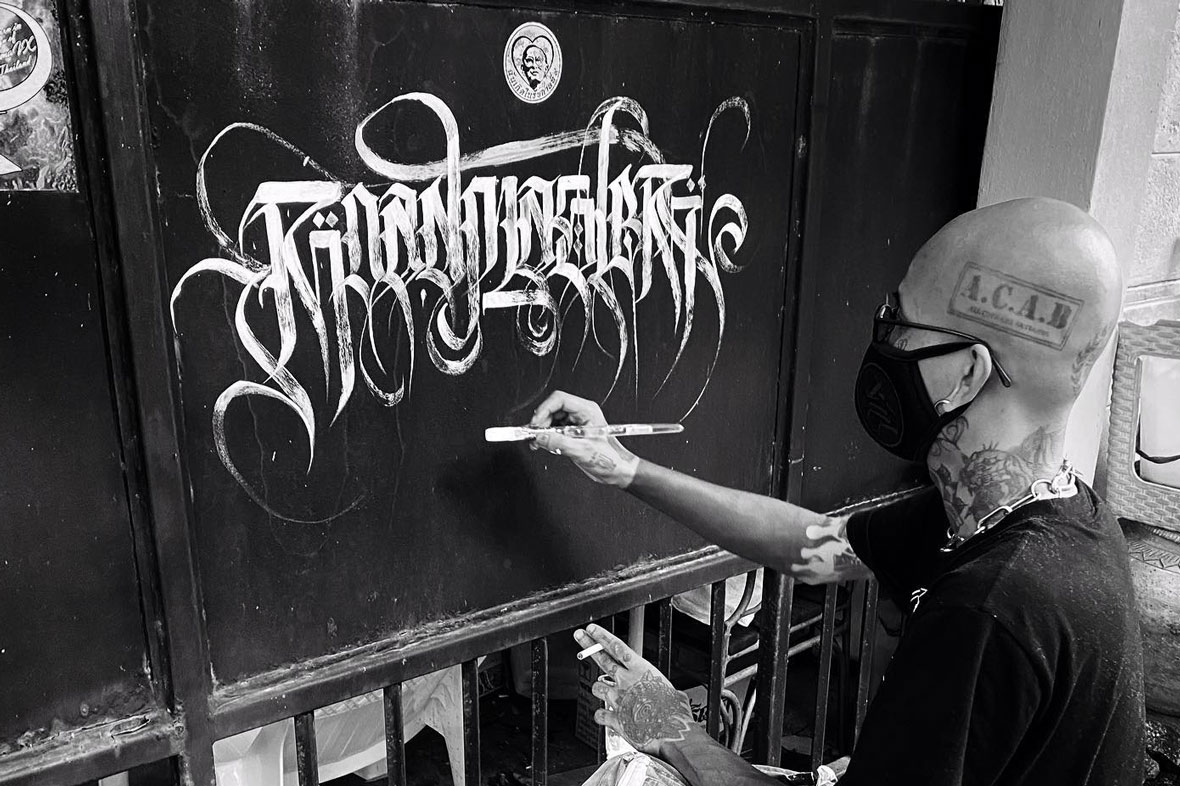
Many overseas Thais are located in the US, primarily in California, so the cultural transmission makes sense. But in Thailand, the adoption of Cholo lettering is not as street-oriented as it is in California. “From my point of view, the gang and neighborhood divisions here are not as serious as they are abroad,” says March Letterror, an artist from Bangkok. “Many people went to California and got influenced by the culture, then they spread it in Thailand.”
Phansan Chandaeng, more commonly known in the art world as Sanblack, is an artist directly inspired by Chicano artists. He had experimented with tattoo art in Thai lettering for a couple years, but it wasn’t until he discovered Chicano-influenced artists in Thailand that he really found his calling. Specifically, he credits Unkle Bigbear, founder of the Lettering Outlaws group, as being a source of inspiration.
In recent years, Chandaeng’s work has been deeply influenced by death metal logos and he primarily works in English. But he has some very personal, local inspirations as well—specifically his mother, who had a job hand painting the lettering on funeral banners. “My mom passed away when I was 15 years old, and I thought she didn’t leave anything for me,” he says. “But then I realized I’ve been familiar with Thai writing style since I was born. At first I was a bit surprised I could do it. I thought back and remembered images of my mom writing it. It’s a truth hidden in sorrow.” He took those memories and kept experimenting with them until he developed his own style.
早期许多漂流在外的泰国人选择在美国生活,特别是在加州,这促进了美国文化在泰国的传播。在泰国,这些字体艺术创作并不像加州那样充满街头的意味。曼谷艺术家 March Letterror 表示:“泰国的帮派文化和社区分帮结派的情况不会像国外那么强烈。许多人是去了加州,受到这种文化影响后,再回到泰国推广开来。”
Phansan Chandaeng(艺名 Sanblack)的创作深受奇卡诺艺术家影响。多年来,他一直在尝试用泰文来进行纹身上的试验,但直到他认识了泰国当地的奇卡诺风格艺术家后,他才真正找到了属于自己的风格,对他影响最深的莫过于“涉法字体“组织的创始人 Unkle Bigbear。
他近期的作品有着强烈的死亡金属风格,以英文为主。而除此之外,在他人生中,母亲曾对他的创作产生过很大的影响。Phansan 说:“母亲的职业曾是为葬礼上的横幅手绘文字。她在我 15 岁那年去世。我以前觉得她没给我留下任何东西。但后来才意识到,泰文书写好像是我与生俱来的天性。我开始也觉得很惊讶,直到后来回想起妈妈绘字时的画面。这对我来说是有点悲伤的发现。”带着这些回忆,他不断尝试创作,直至现在打磨出自己独有的风格。
March Letterror, a 27-year-old artist, got his start bombing graffiti around the Sukhumvit area of Bangkok. He’d put up his name and crew but also leave drippy phrases like “homeless skateboarder.” He’s a punk rocker with an ACAB tattoo stamped on his head. Although he studied fine arts at university, he didn’t graduate, and instead gravitated towards tattoos. He got his start working with an older artist at a shop called Bad Brothers. “Many of us were indeed influenced by Chicano culture, but we adjusted it to our own styles,” he says. “Thai artists receive a lot of influence from abroad, but we don’t always copy them. We maintain the Thai characteristics.”
今年 27 岁的 March 最早在曼谷素坤逸一带创作快速涂鸦 (throw-ups)和签名 Tag。除了自己和团队的名字,他还会留下诸如“没家的滑手”之类饶有玩味性质的标语。他平时还是位朋克乐手,头上刻有 ACAB 字样的纹身。他大学时修读美术专业,但中途辍学并开始钻研纹身创作,与一位年长的师兄在一家名为 “坏哥们儿” 的纹身店里打工,“我们中很多人都受奇卡诺文化的影响,但我们还是会按照自己的意愿进行风格的延伸。泰国艺术家深受国外艺术文化的影响太多,但我们不是生搬硬套,而是想着法子去保持泰国本地特色。”
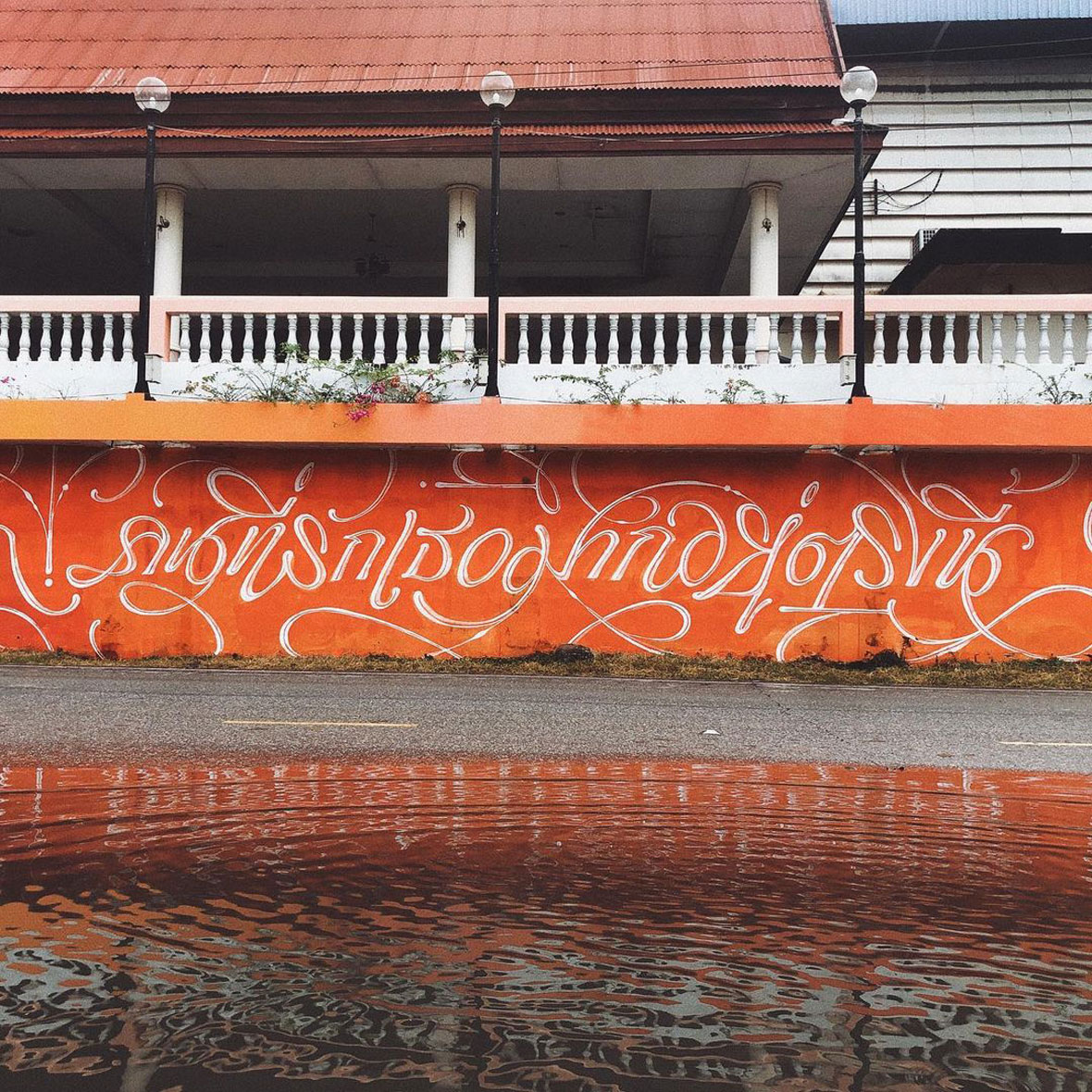
While most artists recognize the influence of Chicano lettering in Thailand, they don’t all relate to it personally. Korn Kittiligraphy, for example, credits Russian calligraffiti artist Pokras Lampas as his main inspiration. “I see Chicano inspiration in Thailand as an imitation of someone else’s culture, so I don’t care much to use myself,” adds Tach Saranyatach, an artist better known as FCKNGNS. He cites European artists and philosophy as being more influential. His style and content is particularly aggressive. The letters are razor-edged, almost brutal, and feel relentless in their repetition of marks. The messages he delivers are a pairing of bleak nihilism and outspoken defiance, with phrases such as “Kill the Rich” and “Long Live Death.” Still, he points to tattoo shops like King Star and its owner Kling as influential pioneers in Thailand, noting that they’ve worked with Chicano styles since 1998.
“In my opinion, contemporary calligraphy in Thailand comes from two main strands. One stems from an interest in fine arts and hip-hop culture. The other is an interest in the history of written characters and linguistics,” agrees Phasukdee (BlackThoracic), placing himself in the latter category.
大多数艺术家都肯定了奇卡诺文化在泰国的影响,但并非每一位泰国艺术家都围绕这种风格来进行创作,例如,Korn(艺名 Kittiligraphy)称俄罗斯书法艺术家 Pokras Lampas 才是他的主要灵感来源;Tach Saranyatach (艺名 FCKNGNS)所受到的影响也主要来自欧洲。Tach 来自曼谷,他说道:“我感觉在泰国,奇卡诺元素只不过是对外来文化的一种效仿,太多人在做了,我自己不太喜欢用。”
他还认为,哲学和欧洲文化更启发他。他的作品大胆且激进,字体线条铿锵有力,近乎霸道,字迹间重复交叠的形式给人一种冷峻的美感。其作品内容结合了冷冽的虚无主义和直言不讳的抗议,譬如 “杀死富人” 与 “死亡万岁” 的组合。但他也认为,像 “皇帝之星”(King Star,泰国传奇纹身店)这样的纹身店及其背后主理人 Kling 是泰国此类艺术的先驱,他们自 1998 年以来一直致力于奇卡诺风格的创作。
“泰国书法有两大派系,一种源于对美术和嘻哈文化的兴趣,另一种源于对历史人物和语言学的兴趣,” Nareadom 表示自己属于后者。

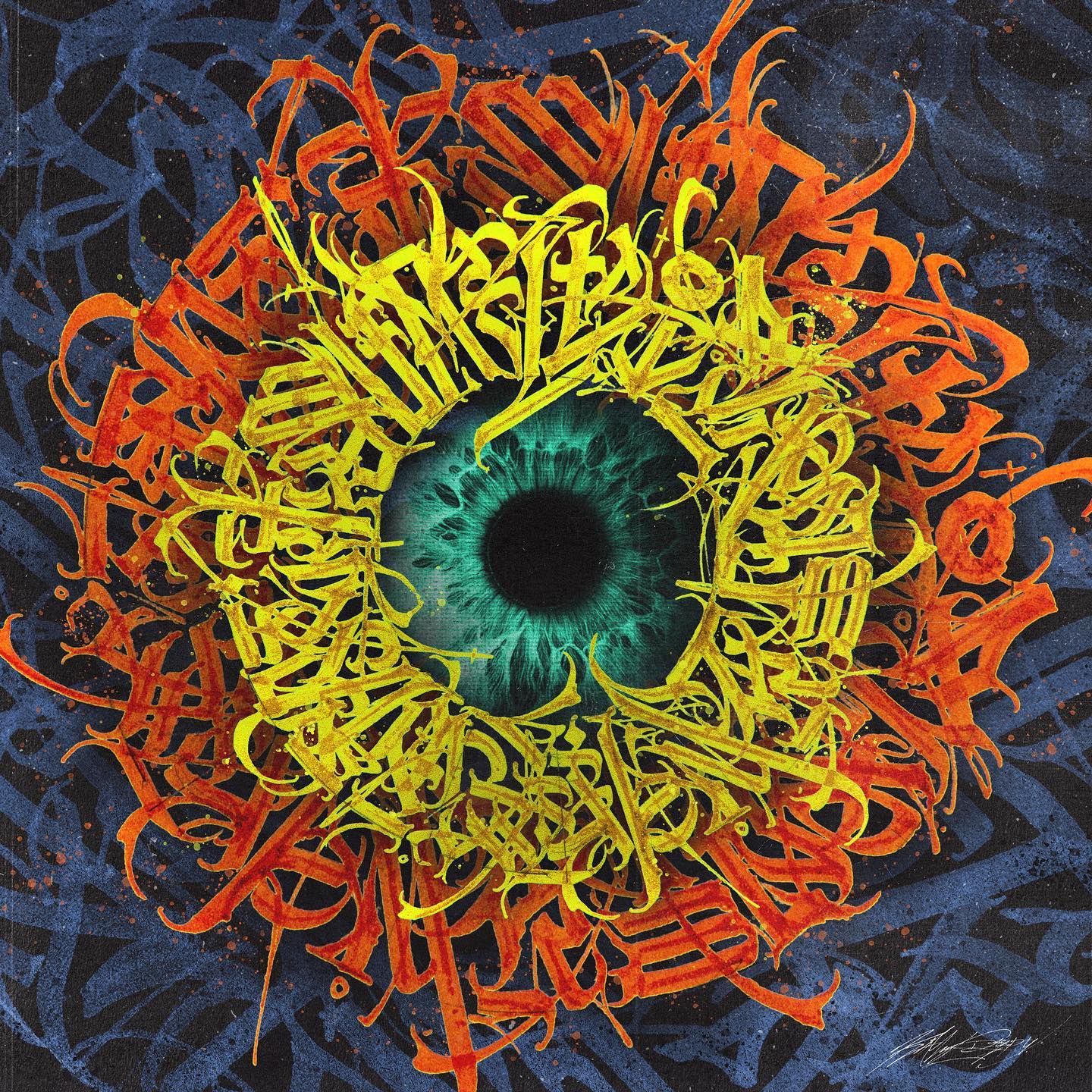
Sorravis Prakong is another Bangkok born-and-raised artist who has been toying with letters since childhood. “When I was in elementary school, I’d peek at friends’ notebooks and copy their writing style. I’d also forge parents’ signatures for friends,” he laughs. He continued exploring the potential of type throughout his life, and although he studied jewelry design at university, he continued to pursue his passion for letters the whole time.
The majority of Prakong’s work is written strictly in Thai, and the roots of his style often come from his home country as well. “A lot of my inspiration comes from old shop signs I’ve passed along the road. I adjust, mix, and experiment with them until I have a new design.” He also points to movie posters and old Thai advertisements as foundational to his work. “One style I’m excited to work with is the classic Thai Naris font. It’s a traditional style that’s difficult to find these days, but I want to bring it back for our era.” Thai Naris was one of the first loopless scripts from the turn of the 20th century and was used for official documents. Thai traditionally has circular loops along the corners and this style simplified the text, cutting off that extra flourish. It loaned itself well to reproduction which led to widespread use across the country for signage, advertisements, and the printing press. Many of the recent scripts Prakong has created are Thai but rooted in blackletter, with long, flowing tails and chunky shoulders and eyes.
Sorravis Prakong 是土生土长的曼谷人,从小对字体创作充满热情,“上小学时候,我喜欢偷看朋友的笔记,然后模仿他们的字迹,我还会帮朋友伪造家长签名,”他笑着说。大学时他主修珠宝设计专业,但仍一直不断探索字体创作。
不同于许多同龄艺术家,Sorravis 大部分作品是用泰语完成,灵感也往往来自泰国本土,“我的很多灵感来自路上看到的旧店招牌,然后通过自己调整、糅合和不断尝试,直到创作出全新的设计。”除此之外他还表示,电影海报上的字体也是他创作的根基,“我特别喜欢的一种字体风格叫作 Thai Naris 字体。这是一种传统的经典字体,现在已经很少见,而我则希望能把它重新发扬光大。”Thai Naris 是泰国最早的无圆圈字体之一,诞生于十九、二十世纪之交,主要用于起草正式文件。这种字体非常适合复印,因此广泛用于全国各地的标牌、广告和印刷媒体。
最近,Sorravis 在创作中有了新的尝试,其大多是基于哥特字风格创作的泰文字体,字尾长而飘逸,字肩和字眼较为粗厚。

Other artists explore Thai scripts as well. Ajahnman is a tattooist in Koh Phangan, an island in the southeast popular with tourists, who combines modern calligraphy with traditional sak yant tattoos. His letters mix hard, straight lines with luxurious looping curves. They stretch upward, often following the form of fluke yarn, which swirls with mad energy until rising above in a calm, focused line.
And Tusk is from Northern Thailand, where the ancient Lanna script is being resurfaced after being suppressed by nationalists in the 30s. He combines it with global styles like Cholo lettering, old English, and Japanese calligraphy, which is called shodo. Historically called Tua Tham or Tai Tham, Lanna had been the primary written language in the region, but it’s no longer used in daily life anymore. To learn it, he had to go to temple where monks have kept the practice alive. The script comes in two forms, either the harder-edged version of Khmer script used to write Thai—which is Tusk’s preference—or it takes the rounder, more circular approach of Burmese.
还有更多艺术家尝试探索泰国本土字体,比如这位来自泰国东南部旅游胜地帕甘岛的纹身师 Ajahnman,他将现代书法与传统的刺符纹身纹身相结合。字母由硬朗直线和华丽曲线构成,像针织毛线一样旋转并连接在一起,凝结出一股狂躁的能量,又在顶端归结出冷静且集中的线条。
以及这位来自泰国北部的艺术家 Tusk。在那里,三十年代曾被民族主义者压制的古老的 Lanna 语正在重新出现。Tusk 将这种文字与世界语言相融,如 Cholo 字、古英语和日本书法(Shodo)。Lanna 语在历史上也被称为 Tua Tham 或 Tai Tham,是该地区主要的书面语言,但在日常生活中已不再使用。而当地的一些僧侣还在沿用这种语言,为了学习,Tusk 不得不去寺庙。该文字有两种书写形式,一种是类似于高棉文字的较硬版本,另一种则是采用缅甸文字中更为圆润的方式,Tusk 更喜欢前者。

There are plenty of untapped local inspirations for younger artists to draw from, whether that be historic fonts, the local printed word, or storefront signage. But even if they choose to look abroad for direction, to Europe or Mexican-Americans, today’s artists have certainly proved they’re capable of making them their own. None of these artists simply recreate anything, they take all this input and use it as a jumping point for something new but explicitly Thai, regardless of inspiration. And the next generation can take that even farther in new directions. After all, nothing comes from a void.
对于年轻艺术家来说,无论是历史中曾发生过的字体遗迹、印刷制品还是店铺门牌等等,泰国本地都蕴藏大量有待发掘的创意灵感。但同时,这帮艺术家们也证明了,即使是外来文化,也能化为己用,无论是来自欧洲、美洲的各地区文化,他们并不选择原封照办,而是在尊重根源和泰国文化的基础上推陈出新。毕竟,艺术不是空穴来风,一代人有一代人的思考,不同时代有着不同的诠释。
Like our stories? Follow us on Facebook and Instagram.
Instagram:
@blackthoracic_itda
@marchletterrorink__
@kittiligraphy
@fckngnsbkk
@sorravis.p
@sanblack.spb
@ajahnman
@tusk6
Contributor: Mike Steyels
Chinese Translation: Olivia Li
Instagram:
@blackthoracic_itda
@marchletterrorink__
@kittiligraphy
@fckngnsbkk
@sorravis.p
@sanblack.spb
@ajahnman
@tusk6
供稿人: Mike Steyels
英译中: Olivia Li

